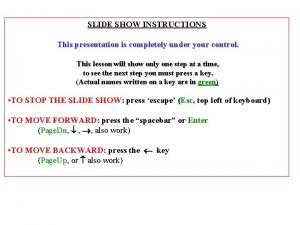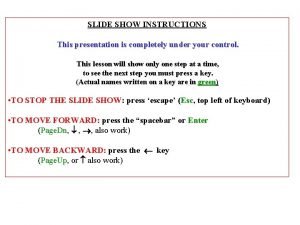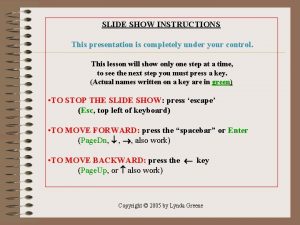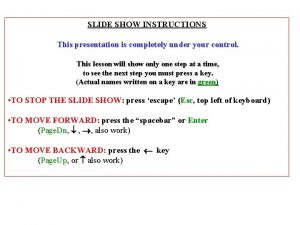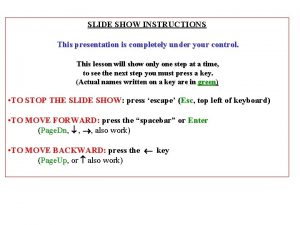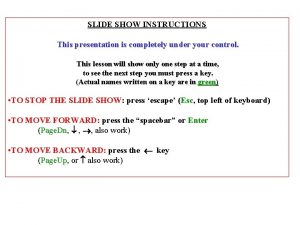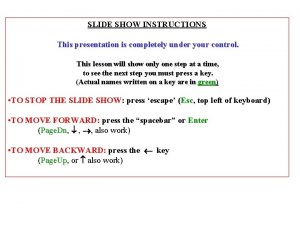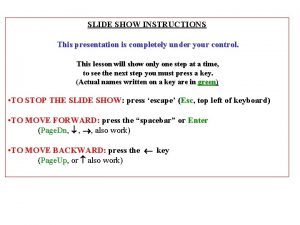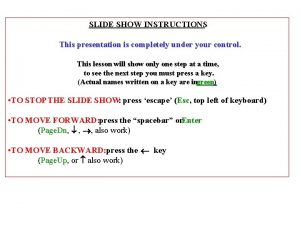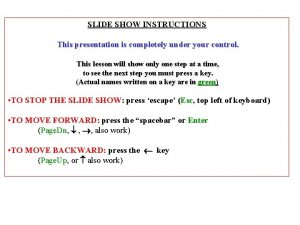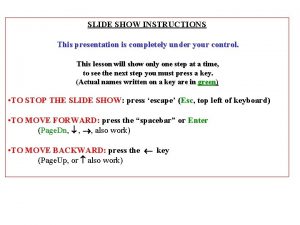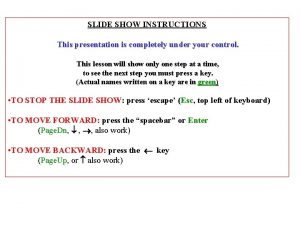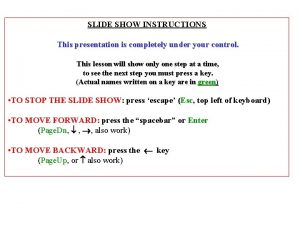SLIDE SHOW INSTRUCTIONS This presentation is completely under



















- Slides: 19

SLIDE SHOW INSTRUCTIONS This presentation is completely under your control. This lesson will show only one step at a time, to see the next step you must press a key. (Actual names written on a key are in green) • TO STOP THE SLIDE SHOW: press ‘escape’ (Esc, top left of keyboard) • TO MOVE FORWARD: press the “spacebar” or Enter (Page. Dn, , , also work) • TO MOVE BACKWARD: press the key (Page. Up, or also work)

The Greenebox Factoring Method ã Copyright 1999 Lynda Greene all rights reserved 2

Factoring Trinomials: 1. Split the middle term 2. Factor using the box 3

SPLITTING THE MIDDLE TERM The Greenebox factoring method uses a box with four spaces in it. That means it works on polynomials that have 4 terms. In other words: A polynomial with 4 -terms can be put into the box and factored immediately. A polynomial with 3 -terms can be put into the box after we change three terms back into the original four This is called “splitting the middle term”. 4

Why do some polynomials have 3 terms and others have 4? When the FOIL multiplication method is used to multiply 2 binomials, for example: (x + 3)(4 x - 2) or (a + b)(c - d) Each answer will have four terms (First, Outer, Inner, Last) If the Outer and Inner terms can be combined, the result will be a Trinomial (3 terms). (x + 3)(4 x - 2)= x 2 - 2 x + 12 x - 6 = x 2 + 10 x - 6 If they cannot be combined, it keeps all 4 terms. (a + b)(c - d) = ac - ad + bc - bd An earlier lesson covered the process for factoring 4 -terms, this tutorial covers factoring 3 -term polynomials.

II. Factoring a Trinomial of the form: ax 2 + bx + c First (a) 3 terms: Middle (b) Last (c) 2 x 2 + 9 x + 10 First, we will split the middle term into the original outer and inner terms. This gives us a four term polynomial which we can factor using the Greenebox method. 6

first Splitting the middle term Step 1: Multiply first*last 2 x 10 = 20 Step 2: Find all the FACTORS of 20 Step 4: Which pair of factors gives us the middle term? 20 2 2 x Add 1 20 = 21 2 10 = 12 4 5 = 9 middle last + 9 x + 10 Step 3: The sign of the last term tells us whether to add or subtract the factors of 20. Since the middle term is 9 x, the original 4 and 5 each had an“x”. (They were like terms and were added together) Step 5: Choose the correct signs. FACT: We add numbers when they have the same signs. (step 3). i. e. The factors are both positive, positive + 4 x and + 5 x OR both negative, negative 4 x and -5 x + 4 x and + 5 x = + 9 x This pair gives us the correct middle term. 7

1. Split the middle term into 2 terms 2 x 2 + 9 x + 10 F O I L Note: We did step 1 on the previous page 2 x 2 + 4 x + 5 x + 10 2. Place each term in the correct location in the box x F 3. Factor out GCF for each row & column 2 x +2 O 2 2 x I + 4 x L 4. Answer: (x + 2)(2 x + 5) +5 + 5 x + 10 8

Step 1: Multiply first*last first 3 x 8 = 24 2 3 x Subtraction last example - 10 x - 8 Step 2. Find all the factors of 24 24 Step 3: Pick the pair that subtract to equal -10 x (the middle term) 1 * 24 2 * 12 3* 8 4* 6 Step 4: Pick the correct signs: (Subtract means: different signs) +12 x - 2 x = +10 x - 12 x + 2 x = -10 x SUBTRACT = 23 = 10 = 5 = 2 This pair works correct terms: -12 x and +2 x 9

2 3 x 1. Split the middle term into 2 terms F 2 3 x - 10 x - 8 O I L + 2 x - 12 x - 8 2. Place each term in the correct location in the box +2 3 x F 3. Factor out GCF for each row & column 2 3 x x I -4 O +2 x L 4. Answer: (3 x + 2)(x - 4) - 12 x - 8 10

II. Factoring a Trinomial of the form: x 2 + bx - c Note: first= 1 x 2 +3 x - 10 Step 1: Multiply the first*last Step 2: Find the factors of 10 Step 4: Choose the pair of factors that equal + 3 x (the middle term) When subtracting, the signs will be different (One “+” , the other “-”) Now factor it 10 Step 3: Subtract 1 * 10 = 9 2*5 =3 1 * 10 = Step 5: Choose the correct signs: -2 x and +5 x = +3 x or -5 x and +2 x = -3 x 11

2 x Split the middle term into 2 terms F 2 x + 3 x - 10 O I L + 5 x - 2 x - 10 Place each term in the correct location in the box F Factor out GCF for each row & column x x O +5 x 2 + 5 x I - 2 x L - 10 Answer: (x + 5)(x - 2) 12

SPECIAL CASE!!! There are some polynomials that have a factor that must be taken out before using the box. Take a polynomial such as: 4 x 2 + 10 x - 6 This polynomial has a common factor of “ 2” in all three terms. If this is not taken out before using the box, the “ 2” will be taken out twice, doubling the answer. (Example on the next two slides) This is a useful feature of the Greenebox Method. It forces the student to take out the GCF BEFORE trying to factor the terms by catching extra factors which might otherwise go unnoticed. If an extra factor is not taken out at some point, the answer will be wrong.

The way this problem should NOT be worked This problem has a GCF of “ 2”. We’ll pretend we didn’t see it and work the problem normally, 2 4 x + 10 x - 6 Step 1: Multiply the first*last Step 2: Find the factors of 24 Step 4: Choose the pair of factors that equal + 10 x (the middle term) 4 * 6 = 24 1 * 24 2 * 12 3*8 4*6 Step 3: Subtract = 23 = 10 =5 =2 Step 5: Choose the correct signs: -2 x and +12 x = +10 x or 2 x and -12 x = -10 x

The way this problem should NOT be worked 4 x 2 + 12 x - 6 Put the four factors into the box and factor it The box “SEES” the “ 2” in both dimensions and pulls it out twice!!! 2 x + 6 4 x 4 x 2 + 12 x - 6 If we check the answer using FOIL, we DO NOT get the original problem!!! 4 x 2 + 10 x - 6 (2 x + 6)(4 x - 2)= 8 x 2 + 20 x - 12 X WRONG ANSWER!!!!!! THIS MEANS THERE WAS A FACTOR WE MISSED!!! 15

The way this problem SHOULD be worked This problem has a GCF of “ 2”. We’ll factor it out then work the problem normally using only the trinomial (in parentheses). 4 x 2 + 10 x - 6 = 2 (2 x 2 + 5 x - 3) Step 1: Multiply the first*last 2*3=6 Step 2: Find the factors of 6 1*6 2*3 Step 4: Choose the pair of factors that equal + 5 x (the middle term) Step 3: Subtract =5 =1 Step 5: Choose the correct signs: -x and +6 x = +5 x or x and -6 x = -5 x

The way this problem should have been worked 2 Example: 2 (2 x + 6 x - 3) Now, place the four terms into the box and factor normally x 2 x 2 2 x -1 -x +3 + 6 x -3 Don’t forget to put that extra “ 2” in the answer!!! 2(x + 3)(2 x - 1)= 4 x 2 + 10 x - 6 17

Some practice problems 1. 4 x 2 - 5 x - 6 2. 3 y 2 - 16 y + 5 4. 2 x 2 + 9 x - 18 x 2 + 3 x + 2 5. x 2 - 4 x - 12 3. Answers: 1. (4 x + 3)(x - 2) 2. (3 y - 1)(y - 5) 3. (2 x - 3)(x + 6) 4. (x + 1)(x + 2) 5. (x - 6)(x + 2) 18

End of Tutorial Go to www. greenebox. com for more great math tutorials for your home computer Questions? send e-mail to: lgreene 1@satx. rr. com
 Heel toe polka steps
Heel toe polka steps Cha cha slide line dance
Cha cha slide line dance Slide todoc.com
Slide todoc.com Sabbath school slideshow
Sabbath school slideshow Naruto chart
Naruto chart During a slide show luis wants a picture to appear
During a slide show luis wants a picture to appear Show not tell generator
Show not tell generator Factor slide and divide
Factor slide and divide Presentation outline slide
Presentation outline slide Housekeeping slide for presentation
Housekeeping slide for presentation Maijdee balika bidyaniketan
Maijdee balika bidyaniketan Allppt layout clean text slide for your presentation
Allppt layout clean text slide for your presentation Allppt layout clean text slide for your presentation
Allppt layout clean text slide for your presentation Allppt layout clean text slide for your presentation
Allppt layout clean text slide for your presentation Allppt layout clean text slide for your presentation
Allppt layout clean text slide for your presentation Allppt layout clean text slide for your presentation
Allppt layout clean text slide for your presentation Educational purposes only disclaimer example
Educational purposes only disclaimer example Acknowledgement for ppt
Acknowledgement for ppt Allppt layout clean text slide for your presentation
Allppt layout clean text slide for your presentation Which statement best describes a good presentation slide?
Which statement best describes a good presentation slide?




















